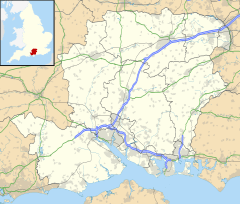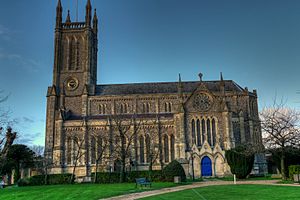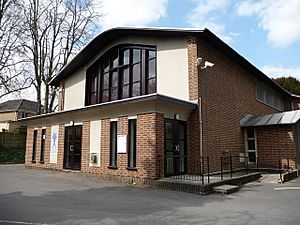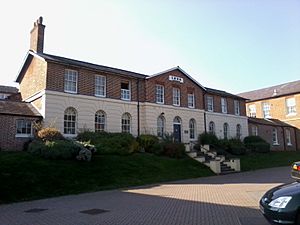Andover, Hampshire facts for kids
Quick facts for kids Andover |
|
|---|---|
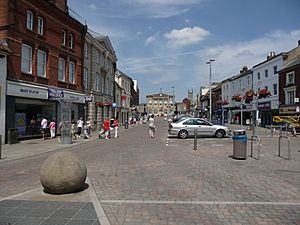 High Street with Andover Guildhall at the top of the street |
|
| Population | 50,887 (2021 Census) |
| OS grid reference | SU3646 |
| Civil parish |
|
| District |
|
| Shire county | |
| Region | |
| Country | England |
| Sovereign state | United Kingdom |
| Post town | Andover |
| Postcode district | SP10, SP11 |
| Dialling code | 01264 |
| Police | Hampshire |
| Fire | Hampshire |
| Ambulance | South Central |
| EU Parliament | South East England |
| UK Parliament |
|
| Website | Town Council |
Andover (/ˈændoʊvər/ AN-doh-vər) is a town in Hampshire, England. It is located in the Test Valley area. The town sits by the River Anton, which flows into the larger River Test. Andover is also right next to the important A303 road. It is at the eastern edge of Salisbury Plain.
Andover is about 18 miles west of Basingstoke. It is also 14 miles from Winchester. Southampton is 35 miles south, and London is about 65 miles away.
Long ago, Andover was a key place for grinding grain into flour. It was also important for processing wool. In the 1900s, the town became a major base for the British Armed Forces.
Contents
Andover's Past
Early History of Andover
Andover's name first appeared in writing around 955 AD. It was called Andeferas in Old English. People think its name comes from an old Celtic word. It might mean "ash tree water."
The town is first mentioned in history in 950 AD. King Eadred built a royal hunting lodge there. In 962, King Edgar the Peaceful held an important meeting. It was like a Saxon parliament, called the Witenagemot. This meeting happened at his hunting lodge near Andover.
A very important event happened in 994. A Viking king named Olaf was baptized in Andover. He was an ally of the Danish king Sweyn Forkbeard. This Olaf was either Olav Trygvason or Olof Skötkonung. The baptism was part of a deal with King Ethelred the Unready. The deal was that Olaf would stop attacking England and go home.
Olav Tryggvason became king of Norway in 995. He tried to make his country Christian. He died in the Battle of Svolder in 1000. Olof Skötkonung was already king of Sweden. He became Sweden's first Christian king. Around 995, he started making Sweden's first coins. English experts helped him with this.
In 1086, the Domesday Book was created. It showed that Andover had 107 male residents. The total population was probably around 500 people. This was quite a large town for that time. Most villages only had 100 to 150 people. Andover also had six watermills. These mills ground grain into flour.
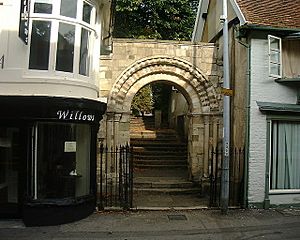
In 1175, King Richard I sold Andover a special document called a charter. This charter gave the townspeople some important rights. They formed a merchant guild, which took over running the town. The guild members chose two officials called bailiffs. These bailiffs were in charge of the town.
In 1201, King John gave the merchants another right. They could collect royal taxes in Andover themselves. In 1256, Henry III allowed the townspeople to hold a court. They could try criminals for crimes committed in Andover. Andover also sent representatives to parliament in 1295 and from 1302 to 1307. The town suffered from two big fires, one in 1141 and another in 1435.
Andover stayed a small market town. Making wool products was the main business. Street names like "Sheep Fair" still remind us of this. A market was held every week, and a fair once a year.
Besides the Church of St Mary, Andover had a priory. It also had a hospital run by monks. This hospital was dedicated to St John the Baptist. There was also a place for people with leprosy, dedicated to St Mary Magdalene.
In 1538, during the English Reformation, King Henry VIII closed the priory and the hospital. In 1571, a free school was started for boys in Andover. This school later became Andover Grammar School. Today, it is known as John Hanson Community School. The original school building has been replaced by houses.
In 1599, Queen Elizabeth I gave the town a new charter. The merchant guild became a corporation. The number of yearly fairs increased from one to three. Like many towns, Andover had outbreaks of the Bubonic plague. These happened in 1603-5, 1625-6, and 1636.
Andover in the 18th and 19th Centuries
During the 1700s, Andover was on the main road from Exeter to Salisbury and London. This made it a very busy stop for stagecoaches. More than 30 stagecoaches passed through the town every day.
In 1789, a canal was opened to Southampton. However, it was not very successful for business and closed in 1859. In 1836, the town started a small police force. It usually had just two police officers and a jailer.
Andover got a railway connection to Basingstoke and London in 1854. The Andover junction station opened on July 3, 1854. This railway also linked the town to Salisbury. A railway line also connected Andover to Southampton. This line was built on the old canal path. However, it closed in 1964.
The town's population grew from 3,304 people in 1801 to 5,501 in 1871. In the 1800s, Andover gained many new facilities. A theatre opened in 1803. Gas street lighting arrived in 1838. A fire station and a small hospital opened in 1877. A swimming pool opened in 1885, and a recreation ground in 1887.
A water company was formed in 1875. It provided piped water to the town. A system of sewers and drains was built from 1899 to 1902. The public library opened in 1897.
In 1845, there was a well-known problem with the workhouse in Andover. The difficult conditions there led to changes in the laws that helped the poor. Andover was one of the towns reformed by the Municipal Reform Act 1835.
The wool industry had become less important. But new businesses started up. Taskers Waterloo Ironworks opened in Anna Valley in 1809. It became very successful. You can see many examples of machines made by Taskers at the Milestones Museum in Basingstoke.
Andover's Modern History
Jobs and Industries
The biggest employer in Andover is the Ministry of Defence. RAF Andover opened on Andover Airfield during the First World War. It became the home of the RAF Staff College.
In 1926, the Andover War Memorial Hospital opened. It was opened by Field Marshall Allanby. Today, the hospital helps people recover. It also has a minor injury unit and outpatient services.
In 1932, a new industry came to Andover. The printers for Kelly's Directory moved to the town. Andover slowly grew. By 1960, it had about 17,000 people. This was partly because Londoners started moving into new council houses and flats built here.
During the Second World War, the RAF Staff College was the main office for RAF Maintenance Command. Andover also made history in 1945. The first British military helicopter unit was formed at RAF Andover. The airfield is not used anymore. However, the RAF still has a connection through the 1213 (Andover) Squadron, Air Training Corps. After the RAF left, the site became the headquarters for army logistics.
Since 2012, the site has been the home of Army Headquarters. The Armed Forces Chaplaincy Centre is nearby at Amport House. The Army Air Corps Centre and the Museum of Army Flying are at Middle Wallop.
Major companies in Andover include Twinings, the tea and coffee company. Simplyhealth and Lloyds Banking Group are financial companies here. The Stannah Group, which makes lifts, also has its main office in town. There are plans to develop the old RAF Andover site for business and industry.
Town Development and Politics
Andover is part of the North West Hampshire area. Its representative in the House of Commons is Kit Malthouse.
In the 1950s, the local council agreed to a plan with the Greater London Council. Andover would become an "overspill" town. This meant building houses and bringing people and businesses from crowded London. In 1961, a plan was made to grow Andover's population to about 47,000 by 1982. This included building 9,000 new homes.
The first new council houses were ready by 1954. By 1981, the population had grown to 51,000. A bypass road, industrial areas, and a new shopping centre called the Chantry Centre were all built. These changes completely changed the town's look.
The new council houses turned out to be poorly built. The local council had to pay a lot for repairs. But after legal action, the Greater London Council paid a large sum of money. This helped fund a repair program that finished in 1995.
In 1974, the old local councils were replaced by Test Valley Borough Council. This new council covered a larger area, including Andover. Light industry is still the main type of work. Many people also travel to London for work, as it's about an hour away by train.
Today, Andover's population is over 52,000. It is one of four main areas in Hampshire planned for large housing growth. There are plans to build 2,500 homes northeast of the town. In 2010, a local campaign led to the election of a parish council for Andover.
The Town Museum is in the old John Hanson Free School building. In 1986, an Iron Age Museum was added. It displays items found from digs at the nearby Danebury Hill Fort.
Getting Around Andover
Bus Services
Buses in Andover all use the Andover, Hampshire Bus Station. For most routes, this is where they start or end.
Buses serve almost all parts of the town. There are also longer routes to nearby towns and villages. Most buses are run by Stagecoach South. This includes services to Basingstoke and Salisbury.
The Active8 service connects Tidworth with Andover and Salisbury. It is run by both Stagecoach and Salisbury Reds. This service is special because both companies share a timetable and accept each other's tickets. In 2002, Andover also became part of the Cango community bus network.
Train Services
Andover's train station is run by South Western Railway. It is close to the town centre. Trains go to Salisbury, Yeovil Junction, Exeter St Davids, Basingstoke, and London Waterloo. Some trains also stop at places like Whitchurch.
In 2017, the Department for Transport said train times between Andover and London Waterloo would be faster. They expected journeys to be about 11 to 13 minutes shorter by late 2018.
Andover used to have a second station, Andover Town. It was in the town centre on the Andover to Redbridge Line. This line and station closed to passengers in September 1964.
Roads Around Andover
The A303 is a major road from London to South West England. It runs along the south side of Andover. The M4 motorway is to the north. You can reach it using the A34 trunk road. The A34 also continues north to Birmingham.
Andover's Population
In 2021, Andover had a population of 50,887 people.
| Ethnic Groups 2021 | Andover |
|---|---|
| White British | 90.9 |
| White | 4.3 |
| Asian | 2.1 |
| Black | 0.6 |
| Other | 2.1 |
Andover has a growing Nepalese population. This is because of the local army connections with the Brigade of Gurkhas.
Local Media
Local TV news for Andover comes from BBC South and ITV Meridian.
For radio, the town gets BBC Radio Solent (96.1 MHz FM) and BBC Radio Berkshire (104.1 MHz FM). Andover Radio is a local community radio station on 95.9 MHz FM. It started in 2016. The local commercial radio station is Greatest Hits Radio Berkshire & North Hampshire.
The local newspaper for Andover is the Andover Advertiser. It started in 1858 and is now owned by Newsquest.
Andover's Future Vision
Andover Vision is a group that includes residents, community groups, businesses, and public bodies. In April 2017, they created a plan for the town's future over the next 20 years. Local people helped shape this plan through many discussions. The plan aims to help Andover manage changes and allow local people to be active in the town's future.
The Andover Vision has five main goals:
- Being part of a connected community
- Having a great green environment
- Being part of a thriving town centre
- Supporting business, jobs, and skills in the town
- Access to great health
Each goal has "big ideas" that the group will work on. These ideas guide projects and help attract new funding. The Vision supports projects like The Town Mills Riverside Park. It also organizes events like the Christmas lights switch-on and summer "Four Fun Fridays."
An earlier Andover Vision plan from 2005 led to projects like The Lights Theatre and the Odeon cinema. It also helped create the Andover Business Park.
Mills and Milling in Andover
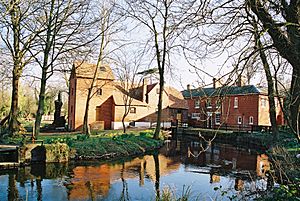
Watermills have been very important in Andover's history. The Domesday Book from 1086 recorded six mills in the area.
Rooksbury Mill is one of the few old mill buildings still standing in Andover. It is first mentioned by name in the 1600s. It worked as a flour mill and had many different owners. Milling stopped there in the early 1900s. After that, the mill building was used for different things, including a small theatre.
Test Valley Borough Council sold the building in 2002. This was shortly after it was badly damaged by a fire. The new owners, Anthony and Sarah de Sigley, restored the building in 2003. They rebuilt much of its original structure.
A large flour mill, McDougalls, is near the railway station.
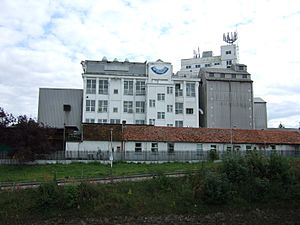
Andover's Climate
Andover has a maritime climate, like much of the UK. This means it has mild temperatures and no very wet or dry seasons. However, it tends to rain more in winter and less in summer.
The closest weather station to Andover is Leckford, about 5 miles south. The highest temperature ever recorded was 34.7 °C (94.5 °F) in August 1990. On average, the hottest day of the year reaches about 29.0 °C (84.2 °F).
The lowest temperature ever recorded was −15.6 °C (3.9 °F) in December 1960. On average, the coldest night of the year drops to about −7.5 °C (18.5 °F). The town usually has about 46 nights with frost each year.
Andover gets about 805mm of rain each year. It rains at least 1mm on about 124 days a year.
Schools in Andover
Andover has state schools, private schools, and special schools. Three state schools provide secondary education: John Hanson Community School, Harrow Way Community School, and Winton Community Academy. John Hanson Community School is the oldest, dating back to the 1500s.
Rookwood School is a private school for students aged 3 to 18. Another local private school is Farleigh School, which is a Catholic prep school. For older students, Andover College offers further education.
Famous People from Andover
- Nigel Spackman was a local football player. He played for Andover before joining bigger clubs like Chelsea and Liverpool. He won the English league championship with Liverpool. He also won many Scottish league and cup medals with Rangers. After retiring, he became a football pundit on TV.
- Bill Rawlings also started his football career in Andover. He joined Southampton in 1919. He scored 175 goals for them, making him their third highest goalscorer ever. He also played for the England team twice in 1922.
- Lucinda Green, a champion horse rider and journalist, was born in Andover in 1953. She won a silver medal at the 1984 Summer Olympics and two world titles.
- Kate Howey, a judo athlete, competed in four Olympic Games. She won a silver medal in 2000 and a bronze medal in 1992. Kate was born in Andover in 1973. She carried the British flag at the opening ceremony in Athens in 2004.
- Ronnie Bond, Pete Staples, and Reg Presley were all born in Andover. They were members of the Troggs, a rock band. They had famous songs like "Wild Thing" and "Love Is All Around".
- The well-known 19th-century surgeon William Morrant Baker was also born in Andover. He is famous for describing a knee condition called Baker's cyst.
- Sam Baker, a novelist and magazine editor, lived in Andover as a child. She went to Anton School, Winton School, and Cricklade Sixth Form College in Andover.
- Author and winemaker Cyril Berry lived in Andover and was its mayor in 1972–1973.
- TV presenter Katie Piper grew up in Andover and still has strong connections to the town.
- TV presenter Richard Arnold grew up in Charlton, Andover. He went to Portway Junior School in Andover.
- Lord Denning, a famous judge, attended Andover Grammar School starting in 1909.
- Hanson Turner received the Victoria Cross, a very brave award.
- Joanna Jensen (born 1970) is a businesswoman known for skin care products.
Sports in Andover
- Cricket: Andover Cricket Club plays in the Southern Premier Cricket League.
- Football: The town has two Non-League football clubs: Andover New Street F.C. and Andover Town F.C.. Andover used to have a team called Andover F.C., but it closed in 2011.
- Hockey: Andover is home to Andover Hockey Club.
- Rugby: Andover R.F.C. is the town's rugby union club.
- Cycling: Andover has a cycling club called the Andover Wheelers.
- Triathlon: Andover is home to the Andover Triathlon Club.
- Archery: The Andover Archer Club is based in the town.
- Lawn Bowls: People have been playing bowls in Andover since 1913.
Andover's Twin Towns
Andover is twinned with several towns around the world. These include Redon in France, Goch in Germany, and Andover, Massachusetts in the United States.
Images for kids
See also
 In Spanish: Andover (Hampshire) para niños
In Spanish: Andover (Hampshire) para niños


